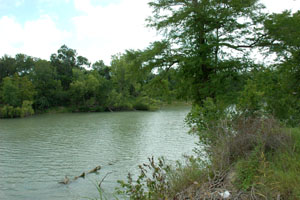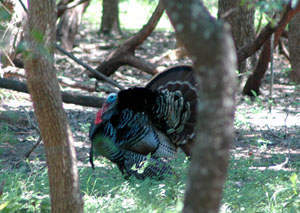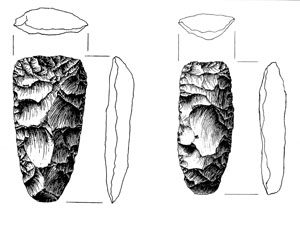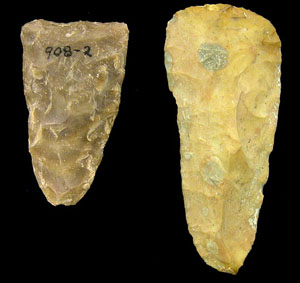Guadalupe Terrace Sites
Prehistoric peoples frequently camped on the floodplain terraces along the lower Guadalupe River drainage basin in Victoria County. Campsite evidence was sometimes either scoured away by major floods or deeply buried by flood deposits of mud and sand. The frequent meanderings of the river and its larger tributaries left some sites stranded high and dry while others were cut apart. The dynamic Guadalupe drainage system is a good example of geological processes in action. Unfortunately, the long-term practice of soil-quarrying has eliminated quite a number of major sites in the floodplain of the Guadalupe between Victoria and Nursery.
Many of the documented Guadalupe Terrace sites have yielded evidence of occupation from Paleoindian times over 10,000 years ago to Late Prehistoric times less than a thousand years ago. Archeologists have long sought to find and thoroughly excavate terrace sites that have ideal stratification—layering through time—that would lead to the formulation of a complete archaeological sequence for the area. Although progress is being made, this quest has proven challenging.
Here we highlight three characteristic Guadalupe Terrace sites. Each of these sites is also typical of the Victoria County area, in that avocational archeologists (including archeological stewards) and local volunteers have long played pivotal roles in their discovery, documentation, and excavation.
McNeill Ranch
The McNeill Ranch site (41VT141) is located near an abandoned channel, or oxbow, of the Guadalupe River about 8 miles northeast of the city of Victoria. Excavations at the site have demonstrated that it was occupied continuously from the Late Paleoindian period through the Late Prehistoric period.
The McNeill Ranch site was discovered as a consequence of commercial mining of the sandy soils near the site when people who had purchased the sand began to notice artifacts and human bones in it. Fortunately, local avocational archeologists learned of the situation and immediately informed the landowners, who agreed to stop the mining operation. Soon thereafter, Jimmy Bluhm and Bill Birmingham organized a group of local volunteers, working through the Museum of the Coastal Bend, to help excavate the site.
Archeologists and students from several Texas universities also became involved in the research. Michael Aiuvalasit studied the alluvial stratigraphy of the site and worked out the depositional history of this section of the Guadalupe River terraces. This geoarcheological study was completed as a M. A. thesis at Texas A&M and represents the kind of research that is greatly needed to interpret the archeological deposits found within the dynamic landscape of the Guadalupe valley.
The site covers more than 16 acres and includes three burial areas. Radiocarbon dates from two of the burials recovered in these areas indicated that they date to the latest part of the Late Archaic period, around 2000 years ago. A third, more recently discovered burial was determined to be about twice as old, dating to the earliest part of the Middle Archaic. Artifacts recovered during excavations date to all periods that the site was occupied and include Golondrina dart points, Clear Fork tools, Scallorn and Perdiz arrow points and, apparently, both bone- and shell-tempered pottery.
The McNeill family has been extremely generous throughout the process of discovery and excavation. This generosity has led to the site becoming an educational resource for all kinds of students; the avocational excavators often lead tours for Boy and Girl Scouts, while a number of university students have received grants (from the Texas Archeological Society) for specialized study of artifacts and human remains from the site.
In the summer of 2006 the University of Texas at Austin held its annual archeological field school at the site under the direction of Dr. Michael R. Bever. Research focused on on the Late Paleoindian and Late Prehistoric deposits. Among the more notable finds were an intact Golondrina point and what is believed to be a Late Prehistoric living surface.
Johnston-Heller
The Johnston-Heller site (41VT15) is located on the west terrace of Rocky Creek, just above that stream’s confluence with the Guadalupe River. In relation to other sites, it is about 2 miles west-southwest of the McNeill Ranch site. Long-time area avocational archaeologist, Bill Birmingham discovered the site and has visited it for over 40 years, often collecting Paleoindian artifacts that had eroded from the high walls of the creek channel. On some occasions, Birmingham recorded in-situ artifacts in the wall, indicating that the deposits were very deep. In the 1960s, he and the late E. H. Schmiedlin (another major figure among area avocationals) carried out test excavations in the upper 40 cm of the deposits (Archaic and Late Prehistoric materials were found). Deep hand-dug excavations, however, were never carried out. Access to the site has been highly limited over recent decades and no proposed large-scale excavations were allowed.
The artifacts found by Birmingham at Johnston-Heller provide evidence of human occupation from Paleoindian through Late Prehistoric times A number of projectile points found at the site indicate Paleoindian occupations; these include Clovis, Plainview, Golondrina points, and Early Stemmed Lanceolate (“Victoria”) points. Elongate, bifacial Clear Fork tools were also found in abundance at Johnston-Heller, these have elsewhere been linked to Paleoindian times.
The depth of the Rocky Creek channel is roughly 25 feet, and cultural materials have come from at least 12 feet below the surface, and some are deeper. There is every reason to suspect that major open-area excavations that penetrated to these depths would find evidence of Paleoindian occupations. A detailed study of Johnston-Heller archaeology is provided by Jacob T. Bourbon in his 1997 MA thesis.
J2 Ranch
The J2 Ranch site (41VT6) was found by the late E. H. Schmiedlin in the early 1960s. He and Birmingham brought photos of the artifacts to the attention of archeologists at the 1966 Texas Archeological Society meeting in San Antonio. The materials included Plainview, Golondrina, Angostura and Scottsbluff. Like McNeill Ranch and Johnston-Heller, the site contains artifacts dating from the Paleoindian to the Late Prehistoric periods. Controlled investigations at the site were spearheaded by Schmiedlin, as part of Southern Texas Archaeological Association fieldwork. The sandy deposits were mixed and did not yield stratigraphic relationships, although the work augmented local collection with a wide range of Archaic projectile points as well as well-preserved animal bone and debitage.
Projectile points recovered include Golondrina, Plainview, and Victoria (Early Stemmed Lanceolate) Paleoindian points, Andice and Darl archaic points, and Scallorn arrow points dating to the early part of the Late Prehistoric period. Bison bone was recovered from the site, as were bones from a number of animals including white-tailed deer, rabbits, turtles and snakes. Other interesting finds were a cache of Guadalupe tools and an incised bone artifact.
Contributed by Jeff Taff.
Sources
Aiuvalasit, Michael J.
2006 Geoarchaeological Investigations at the McNeill-Gonzales Site (41VT141), Victoria County, Texas. Unpublished Masters thesis. Department of Anthropology, Texas A&M University, College Station.
Birmingham, William W. and Thomas R. Hester
1976 Late Pleistocene Archaeological Remains from the
Johnston-Heller Site, Texas Coastal Plain. Papers on
Paleo-Indian Archaeology in Texas 1:15-33.
Bourbon, Jacob T.
1997 Analysis of Artifacts from the Johnston-Heller Site, 41VT15, Victoria County, Texas in the Central Coastal Plain of Texas. Unpublished MA thesis, University of Texas at Austin. 359 pp.
Braun, Pat
2006 Turning the 41VT141 Salvage Site into a Unique Research and
Educational Resource. Current Archeology in Texas 8(1):3-5.
Flaigg, Norman G.
1995 A Study of Some Early Projectile Points from the J2 Ranch Site
(41VT6), Victoria County, Texas: The Schmiedlin-Studer
Collection. La Tierra 22(4):16-55.
Fox, Anne A., E.H. Schmiedlin and J.L. Mitchell
1978 Preliminary Report on the J2 Ranch Site (41VT6), Victoria County,
Texas. La Tierra 5(3):2-14.





